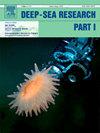Modeling of the isotope (δ18O, δ2H) composition and salinity of the seawater surface layer in polar regions: Application for the East and European arctic
IF 2.1
3区 地球科学
Q2 OCEANOGRAPHY
Deep-Sea Research Part I-Oceanographic Research Papers
Pub Date : 2025-06-18
DOI:10.1016/j.dsr.2025.104547
引用次数: 0
Abstract
The surface sea water salinity and isotope (δ18O, δ2H) composition in polar regions are determined by the balance between freshening and freezing-related processes. Due to sea ice formation and its melting, the relation between the salinity and δ18O(δ2H) values does not correspond entirely to an additive process. We propose the dynamic model of surface layer (DMSL), which considers the fluxes corresponding to the freshening, freezing, and sea ice melting in order to describe the δ18O(δ2H)–salinity and δ18O–δ2H relations in Arctic seawater. The DMSL shows that the slope in the δ–salinity space is a complex function of melting and freezing fluxes, freshwater flux, salinity, and isotope composition of marine and freshwater endmembers. The model can be applied to salinity and isotope signatures both for any whole water region and for single water samples. The testing of the DMSL was done for water areas covered with different freezing–melting activity, located both in shelf areas influenced of continental runoff and in areas isolated from it. The data used for test calculations were obtained for surface (0–15 m) seawater collected in the Eastern and European Arctic in 2017, 2018, and 2021 (70°–82.7° N, and −4° W to 168° E) at the end of ice-free seasons. The calculations show that the model is capable of adequately estimating both the isotope signature of fresh water and the ratio of the main fluxes that form the surface layer: freshening, modification, and the contribution from melting sea ice.
极地海水表层同位素(δ18O, δ2H)组成和盐度的模拟:在东欧和欧洲北极的应用
极地地区表层海水盐度和同位素(δ18O, δ2H)组成由与新鲜和冻结有关的过程之间的平衡决定。由于海冰的形成和融化,盐度与δ18O(δ2H)值之间的关系并不完全符合加性过程。为了描述北极海水的δ18O(δ2H) -盐度关系和δ18O -δ2H关系,提出了考虑海冰新鲜、冻结和融化对应通量的表层动力学模型(DMSL)。DMSL表明,δ -盐度空间的斜率是融化和冻结通量、淡水通量、盐度以及海洋和淡水端元同位素组成的复杂函数。该模型可以应用于任何整个水域和单个水样的盐度和同位素特征。对DMSL的测试是在不同冻融活动覆盖的水域进行的,这些水域既位于受大陆径流影响的大陆架地区,也位于与大陆径流隔绝的地区。用于测试计算的数据是在2017年、2018年和2021年(70°-82.7°N, - 4°W至168°E)无冰季节结束时,在北极东部和欧洲收集的表面(0-15 m)海水中获得的。计算表明,该模式能够充分估计淡水的同位素特征和形成表层的主要通量的比率:新鲜、变质和海冰融化的贡献。
本文章由计算机程序翻译,如有差异,请以英文原文为准。
求助全文
约1分钟内获得全文
求助全文
来源期刊
CiteScore
4.60
自引率
4.20%
发文量
144
审稿时长
18.3 weeks
期刊介绍:
Deep-Sea Research Part I: Oceanographic Research Papers is devoted to the publication of the results of original scientific research, including theoretical work of evident oceanographic applicability; and the solution of instrumental or methodological problems with evidence of successful use. The journal is distinguished by its interdisciplinary nature and its breadth, covering the geological, physical, chemical and biological aspects of the ocean and its boundaries with the sea floor and the atmosphere. In addition to regular "Research Papers" and "Instruments and Methods" papers, briefer communications may be published as "Notes". Supplemental matter, such as extensive data tables or graphs and multimedia content, may be published as electronic appendices.

 求助内容:
求助内容: 应助结果提醒方式:
应助结果提醒方式:


